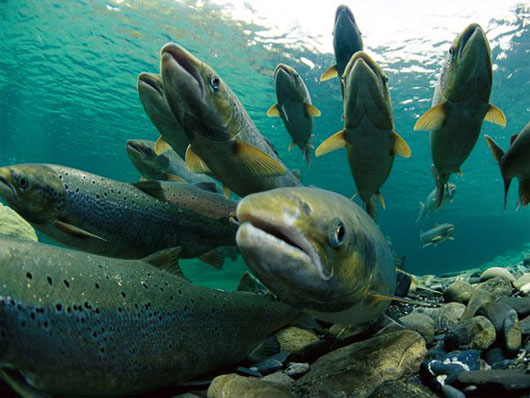Severe drought, the US carries 30 million salmon to the sea
The record drought in California - USA caused the Sacramento River water level and its branches to be alarmingly low. Wildlife conservationists are planning to transport 30 million salmon to the Pacific by trucks instead of letting them thrive.
Steve Martarano, spokesman for the US Department of Wildlife and Fish (FWS), said: 'Bringing the salmon to the sea by means of transportation is not what we usually do and does not want it to happen. . But this is the best way to keep salmon populations from deteriorating. '
Usually between April and June, people leave salmon from artificial hatcheries in the Sacramento River basin moving themselves along the tributaries to the Pacific Ocean. After 3 years, the surviving salmon will flow back to the hatcheries to lay eggs.

In the breeding season, salmon will go upstream to "home" to lay eggs.(Photo: Urban Times)
This year, due to the prolonged drought, the FWS calculated the way to put 30 million salmon on 18-wheel trucks in a river water environment below 60 ° F (about 15 ° C) and continuously traveled for 5 hours. Arrive in San Francisco Bay, then drop them into the cages net at sea. These cages are pulled to the sea, allowing the salmon to adapt to the new environment before releasing them completely.
However, this practice may cause the salmon unaware of the direction and disappear on the way back to the hatchery.
Most California salmon is farmed in four hatcheries in the Sacramento River basin to restore their habitat. A small number of fish farms in the Klamath River system are further north.
The largest number of salmon FWS once transported to the sea is about 9.1 million, spawning from 3 hatcheries in the Sacramento River. The remaining hatchery reared about 12 million young salmon but due to the full river water, there was no need to use a truck to let them swim to the sea by themselves.
California has been dry for three years in a row, threatening to affect half a million acres of farmland and causing billions of dollars in economic losses.
- North Korea suffered the most severe drought in the past five decades
- Brazil: The most severe drought in the past half century
- Earth copes with severe drought
- Dry season 2005-2006: Severe drought?
- More than half of America has suffered from drought
- Unbelievable effects from drought
- Natural disasters: cold in Europe and America, drought in China
- Spectacular migration of red salmon in Canada
- The ancestors of salmon have sharp teeth 20cm long
- Russia implemented a salmon protection project for future generations
- Drought can change the history of humanity
- This is why you should stop eating farmed salmon
 Surprised: Fish that live in the dark ocean still see colors
Surprised: Fish that live in the dark ocean still see colors Japan suddenly caught the creature that caused the earthquake in the legend
Japan suddenly caught the creature that caused the earthquake in the legend A series of gray whale carcasses washed ashore on California's coast
A series of gray whale carcasses washed ashore on California's coast Compare the size of shark species in the world
Compare the size of shark species in the world